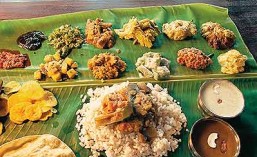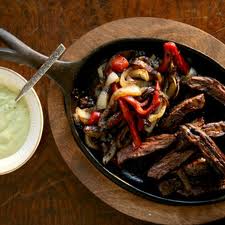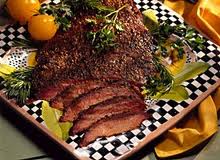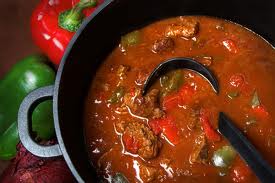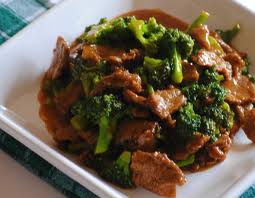It’s always exciting to experience the sensory drama when a hot platter of sizzling fajitas is brought to your table in a Mexican restaurant. Here’s a
recipe for making the same thing at home. It might be less of a performance piece, but it will taste just as great. Traditionally this is made with skirt steak, but flank and sirloin work equally well. The trick is to cook these fast, hot, and no more than medium-rare—which is nice, because it means minimal stove time for you. A cast-iron skillet is perfect for this.
1½ pounds flank, sirloin, rib-eye, skirt, or strip steak, about ¾-inch thick
½ teaspoon salt
1/8 teaspoon freshly ground black pepper
2 tablespoons olive oil
1 medium red onion, thickly sliced
1 large red bell pepper, cut into ¼-inch-wide strips
1 large yellow bell pepper, cut into ¼-inch-wide strips
1 large green bell pepper, cut into ¼-inch-wide strips
1 teaspoon minced garlic (about 1 good-sized clove)
1. Pat the steak dry with paper towels, and season both sides with ¼ teaspoon of the salt and all the pepper.
2. Place a large (10-to 12-inch) heavy skillet over medium heat. After about a minute, add 1 tablespoon of the olive oil and swirl to coat the pan.
Wait another 30 seconds, and then add the steak. Cook, undisturbed, for 1½ to 2 minutes, or until nicely browned. (This will give you a medium-rare
result. If you prefer it more well done, you can cook it as long as 2½ minutes.)
3. Use a metal spatula to loosen, lift, and flip the steak, and cook it on the other side for 1½ to 2 minutes for medium-rare (or up to 2½ minutes for
medium), adding a little more oil if the pan seems dry. Don’t overcook the steak or it will become tough.
4. Transfer the cooked steak to a cutting board or plate, cover it loosely with a tent of foil, and let it rest while you cook the onions and peppers.
5. Without cleaning the pan, return it to the stove over medium heat. After about a minute, add the remaining 1 tablespoon olive oil and swirl to coat
the pan. Turn the heat to medium-high, toss in the onion and bell peppers, and cook, shaking the pan and stirring, for only 3 to 5 minutes, or until
everything becomes even more brightly colored and barely tender. Toss in the garlic and the remaining ¼ teaspoon salt during the last minute of
cooking.
6. Remove the pan from the heat, and let the vegetables rest while you cut the steak crosswise, against the grain, into thin strips. Add the strips of
cooked steak to the vegetables in the pan, and mix briefly to combine. Bring the pan to the table and serve right away
